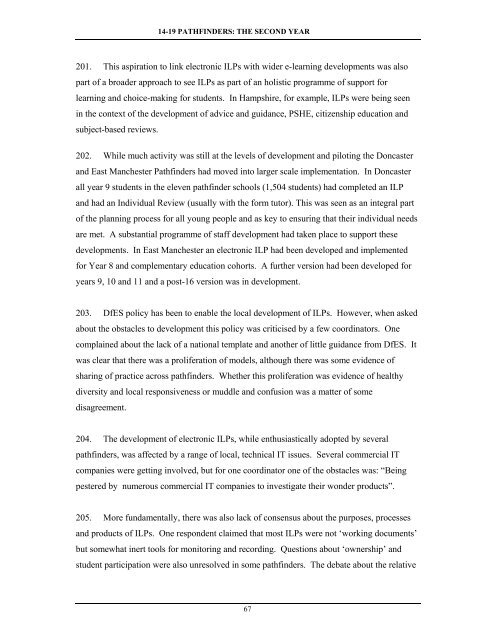Collaborative Approaches to 14-19 Provision - Communities and ...
Collaborative Approaches to 14-19 Provision - Communities and ...
Collaborative Approaches to 14-19 Provision - Communities and ...
- No tags were found...
Create successful ePaper yourself
Turn your PDF publications into a flip-book with our unique Google optimized e-Paper software.
<strong>14</strong>-<strong>19</strong> PATHFINDERS: THE SECOND YEAR201. This aspiration <strong>to</strong> link electronic ILPs with wider e-learning developments was alsopart of a broader approach <strong>to</strong> see ILPs as part of an holistic programme of support forlearning <strong>and</strong> choice-making for students. In Hampshire, for example, ILPs were being seenin the context of the development of advice <strong>and</strong> guidance, PSHE, citizenship education <strong>and</strong>subject-based reviews.202. While much activity was still at the levels of development <strong>and</strong> piloting the Doncaster<strong>and</strong> East Manchester Pathfinders had moved in<strong>to</strong> larger scale implementation. In Doncasterall year 9 students in the eleven pathfinder schools (1,504 students) had completed an ILP<strong>and</strong> had an Individual Review (usually with the form tu<strong>to</strong>r). This was seen as an integral par<strong>to</strong>f the planning process for all young people <strong>and</strong> as key <strong>to</strong> ensuring that their individual needsare met. A substantial programme of staff development had taken place <strong>to</strong> support thesedevelopments. In East Manchester an electronic ILP had been developed <strong>and</strong> implementedfor Year 8 <strong>and</strong> complementary education cohorts. A further version had been developed foryears 9, 10 <strong>and</strong> 11 <strong>and</strong> a post-16 version was in development.203. DfES policy has been <strong>to</strong> enable the local development of ILPs. However, when askedabout the obstacles <strong>to</strong> development this policy was criticised by a few coordina<strong>to</strong>rs. Onecomplained about the lack of a national template <strong>and</strong> another of little guidance from DfES. Itwas clear that there was a proliferation of models, although there was some evidence ofsharing of practice across pathfinders. Whether this proliferation was evidence of healthydiversity <strong>and</strong> local responsiveness or muddle <strong>and</strong> confusion was a matter of somedisagreement.204. The development of electronic ILPs, while enthusiastically adopted by severalpathfinders, was affected by a range of local, technical IT issues. Several commercial ITcompanies were getting involved, but for one coordina<strong>to</strong>r one of the obstacles was: “Beingpestered by numerous commercial IT companies <strong>to</strong> investigate their wonder products”.205. More fundamentally, there was also lack of consensus about the purposes, processes<strong>and</strong> products of ILPs. One respondent claimed that most ILPs were not ‘working documents’but somewhat inert <strong>to</strong>ols for moni<strong>to</strong>ring <strong>and</strong> recording. Questions about ‘ownership’ <strong>and</strong>student participation were also unresolved in some pathfinders. The debate about the relative67
















